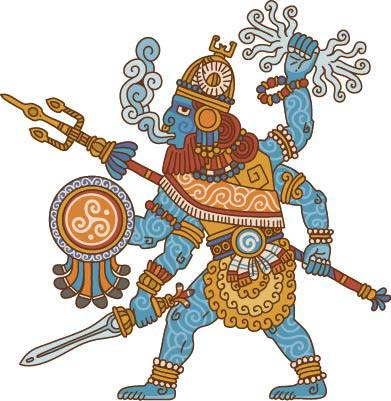So let’s talk RQ art for a moment. For the last fifteen years or so, I’ve worked hard to give RQ and Glorantha a very distinctive and unique look.
Being in Berlin, I was close to Museum Island, with the Pergamonmuseum, the Altesmuseum, Neusmuseum, and the Bodesmuseum, and when the kids went to school in Zehlendorf, I could wander by the Ethnographical Museum (its now on Museum Island). So I could look at a LOT of historical influences – Greek, Etruscan, Hittite, Babylonian, Bactrian, Gandhara, Egyptian, Minoan, Mycenaean, Hallstatt Celt, Mesoamerican, and so on.
I’ve also been very fortunately to work with some incredibly talented artists, like Katrin Dirim, Agathe Pitié Perso, Loïc Muzy, Ossi Hiekkala, Lionel Marty, and many others who helped me bring Glorantha to life.
Let’s mainly focus on Central Genertela (Holy Country, Dragon Pass, Peloria, Prax, and Maniria) as that is probably 95%+ of the art we do and lets look at how some of this gets put together and the ground rules:
- None of the RQ books we are working on have a one-to-one real world culture analogy. They are at a minimum a mashup of several real world art styles.
- Holy Country, Dragon Pass, and Peloria are cultural centers. They produce art that gets traded to others, and they influence others. If I am running a temple and want to hire someone to depict my gods, I probably hired someone from one of those cultural centers.
- These cultures are not hermetically sealed, and they influence each other through trade. There is a lot of cultural transmission between these lands – Sartar is influenced by the Holy Country and Peloria, Peloria is influenced by the Holy Country, etc.
- Avoid things looking much like Romans or Vikings or British Island Celts. First off, there’s too much of that on the market and too much of it looks awful. Glorantha needs to punch out from the rest of the TTRPG and video game settings. I like Skyrim as much as the next person, maybe even more, but Skyrim is Skyrim. Glorantha should not be a TTRPG Skyrim clone.
- Think about the gods and their representation. Orlanth has a LOT of weapons and tools – so give him extra arms so he can be represented with all of them! Below I have an early sketch probably from around 2012 that was instrumental in how I developed the look of Orlanth. Note that it is not particularly South Asian in style – heck, its a stick figure (I normally do concept art in stick figures so the artist I work with can play around with ideas without being preconceived by my references).

![]()
![]()
Now personally, the person I think who has the best feel for how Gloranthan art looks is probably Katrin Dirim. Especially her Dragon Pass and Holy Country materials. Note the Mesoamerican influences on this Orlanth piece. To me that is perfection.

Look carefully at how Orlanth is composed of Air Runes in this piece, but we also have Movement and Master Runes woven throughout. That is amazing. And Orlanth has a sword, lightning, thunderbolt, shield of aran, and mist from his mouth. My only screwup was not insisting that he has sandals!
Here’s another early sketch that ended up influencing the Lightbringers Book a lot. Again, Orlanth has multiple arms, but at the time I wasn’t thinking Indian at all. If anything I think was influenced by some Tibetan art at the Berlin Ethnographical Museum.

